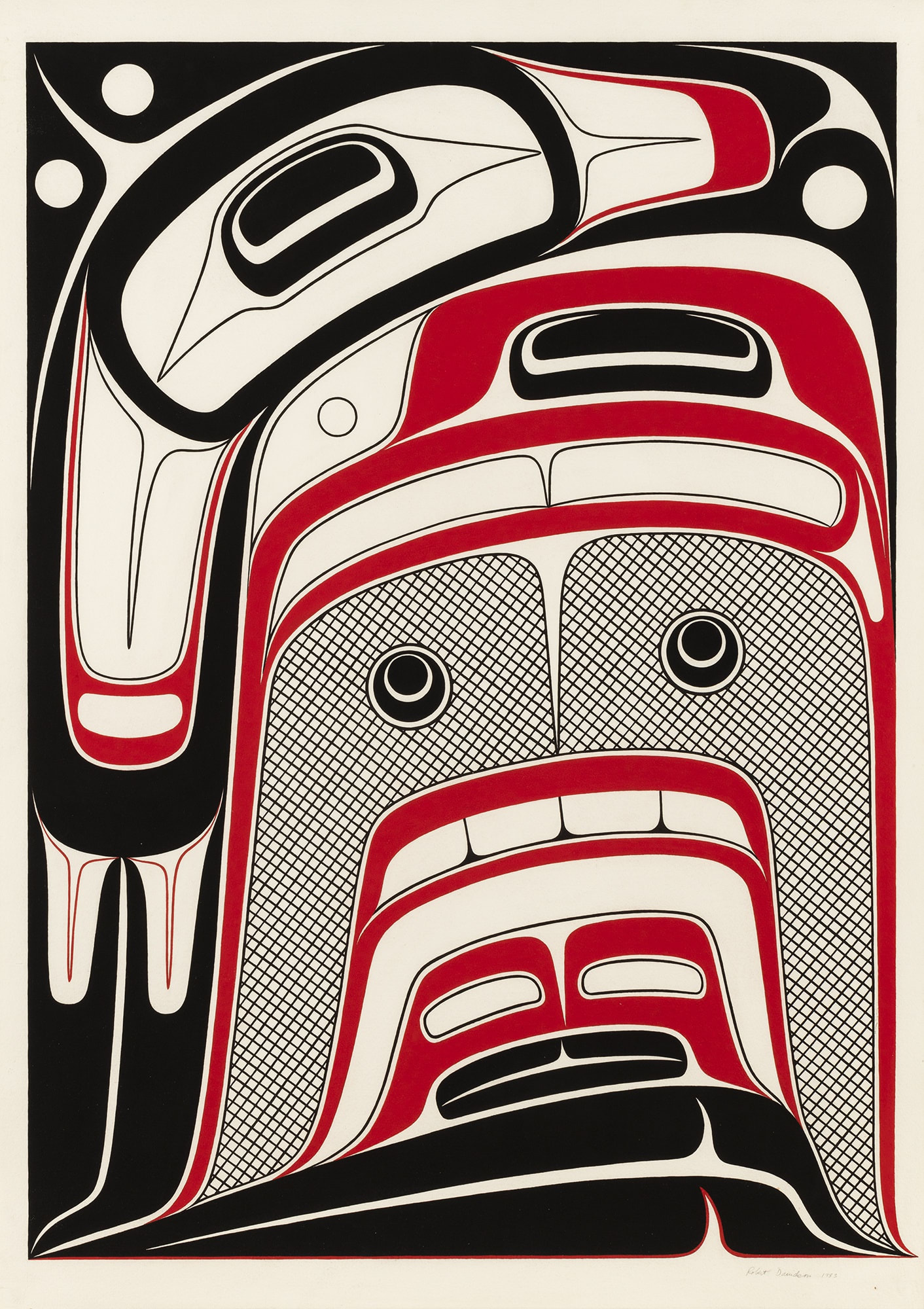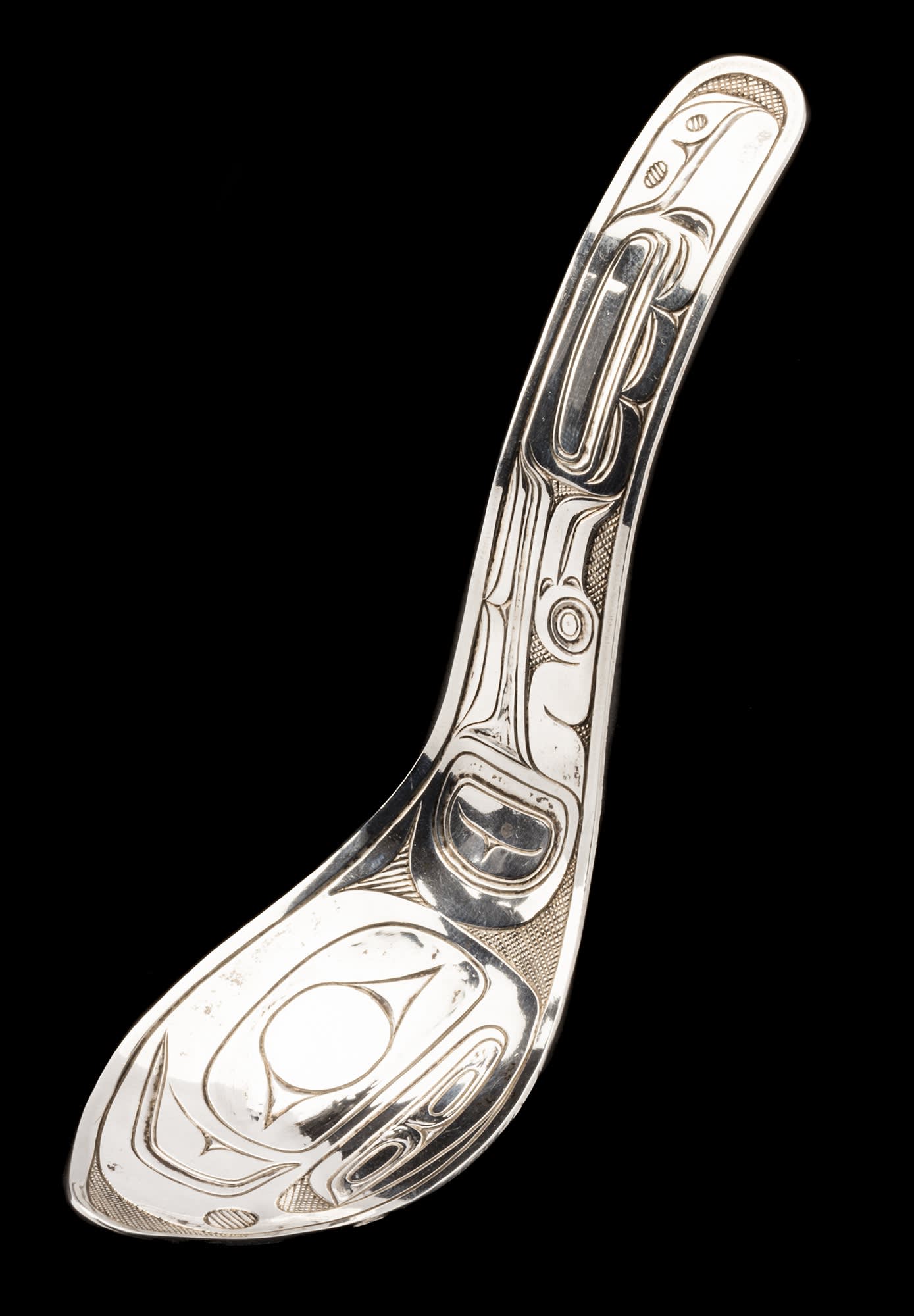ROBERT DAVIDSON (GUUD SANS GLANS), O.C., O.B.C., (1946-) HAIDA, MASSET / WHITE ROCK
Robert Davidson is one of Canada’s most celebrated artists. He has received every national and regional award that can be bestowed upon an artist including the Order of Canada, the Royal Canadian Academy of Arts, the Order of British Columbia, and the Audain Prize. He has also received numerous honorary degrees and international acknowledgments as well as the respect of his peers for his commitment to excellence and his dedication to the preservation of Haida art and ceremony.
In the Haida world, artists are expected to be skilled in a variety of mediums and to be able to work on a scale from miniature to monumental. Davidson is universally considered to be one of the world’s best contemporary wood carvers which is evident in his totem poles, masks and sculptures. He is equally proficient in the two-dimensional painted forms known as formline which is a hardedge design made up of a variety of shapes that are often applied with great tension wrapping around sculpted forms such as masks or canoes of as a stand-alone art form on house fronts, boxes and ceremonial dance curtains.
Robert Davidson was born in Hydaburg, Alaska in 1946 and raised in Masset, British Columbia. He was encouraged by his father and grandfather to carve argillite, learning the sculpted forms and developing a work ethic at a young age. He carved the first totem pole to be erected in his home town of Masset in known memory in 1969. This event led to several international commissions and the opportunity to study Northwest Coast in distant museums. He has hosted numerous potlatches and feasts that honour historical initiatives as well as making a commitment to a stable cultural future. He has produced over 160 editions of limited serigraphs, finely crafted jewellery pieces in wood, gold and silver, masks, totem poles and contemporary sculptures all at a level equal or greater to the high standard set by historic master artists. His work can be found in private, corporate and public collections internationally. His work is included in most publications documenting the modern art form and there are numerous books and catalogues dedicated to his work.
Gary Wyatt
First Arts is pleased to present several works by Robert Davidson in our forthcoming June 12, 2023 Live Auction of Inuit & First Nations Art. Highlights by the artist include:
Lot 50
ROBERT DAVIDSON
U is Transforming, 1983
ESTIMATE: $70,000 — $90,000
Exhibited
Adding More Words to the Dictionary: In Appreciation of Robert Davidson’s most recent paintings, Maple Ridge Art Gallery, Maple Ridge, B.C., 1983.
Exhibited and Published:
Inuit Gallery of Vancouver, Robert Davidson: An Exhibition of Northwest Coast Native Art, 13 April - 4 May 1989, illustrated catalogue;
Vancouver Art Gallery and the Canadian Museum of Civilization, Robert Davidson: Eagle of the Dawn, 1993-94. Catalogue: Ian Thom, ed., Robert Davidson: Eagle of the Dawn (Vancouver: Vancouver Art Gallery, 1993), p. 105. This was the first major public exhibition of Davidson’s work; the book remains the definitive study of the artist’s work and career to that point.
Published
Gary Wyatt with Robert Davidson, Echoes of the Supernatural: The Graphic Art of Robert Davidson, (Vancouver: Figure 1 Publishing Inc., 2023), p. 100, as “U is Transforming I” to differentiate it from the second painting of the same title by Davidson.
U is Transforming was shown at the first major exhibition of Davidson’s paintings, and springs from a highly experimental and creative period that would establish a new direction and medium for the artist.
In the years building towards the 1967 landmark exhibition Arts of the Raven at the Vancouver Art Gallery, Robert Davidson was introduced to the work of a historical anonymous master artist whom Bill Holm and Bill Reid had named the ‘Master of the Black Field.” This artist would become an early influence on Davidson’s work – the Master’s ability to establish a shape within a shape and then design both the primary and internal designs in relation to each other was a critical influence on pieces throughout Davidson’s career. Davidson believes that each shape has its own supernatural and natural presence that can be brought to life.
In 1983 Davidson began painting as a serious medium; this led to an important early exhibition titled Adding More Words to the Dictionary – In Appreciation of Robert Davidson’s most recent paintings at the Maple Ridge Art Gallery. U is Transforming was included in this exhibition. Many of these paintings featured large formline elements within a shape which became the external form for the subject – titles such as Wolf Inside Its Own Foot, Seawolf Inside Its Own Dorsal Fin, and U is Transforming were strong examples of his new direction in designing. Five of these paintings were all sold as a set; this was Davidson’s first major painting sale, and it shifted his work towards producing original paintings. These same five paintings became the designs for a 1983 print series; these are among the most collected and documented images of the modern art form.
U is Transforming was released for sale in the 1989 catalogued solo exhibition Robert Davidson at the Inuit Gallery of Vancouver. This exhibition was one of the first exhibitions to experiment with not pre-selling the exhibition; all major works were sold to people who formed a line in front of the gallery. The clients travelled from many international cities to participate in the sale and the ceremonial opening with the artist. Davidson has included paintings in every major commercial and retrospective exhibition since that time.
Gary Wyatt
ROBERT DAVIDSON
Eyes of the Mind, 1996
ESTIMATE: $15,000 — $25,000
When I realized that my spirit has a helper, I started to wonder if my mind has eyes.
(Robert Davidson’s description of this work, 1996)
Robert Davidson (Guud Sans Glans) began working in bronze as a possible medium for public art commissions in the mid 1980s. While visiting the site that would become a commission for three totem poles titled Three Variations of the Killer Whale Myth at the Donald M. Kendell Sculpture Garden, Pepsico World Headquarters in Purchase, New York, Davidson carried a wooden frog medallion in his pocket, which he famously described as squirming and trying to leap into the pond in front of the poles. This led to a commission for a three-foot bronze casting in which the “medallion” floats just above the surface of the pond. Davidson decided to experiment with smaller bronze editions to maintain market presence during a decade in which his work was in extremely high demand. He would leave bronze as a medium in favour of hollow aluminum sculptures, which he could adjust in scale from tabletop to monumental works that could withstand Canadian winters in public spaces.
Lot 87
ROBERT DAVIDSON
Spoon, c. 1976
ESTIMATE: $7,000 — $10,000
Robert Davidson credits spoons as being an important transition in his carving style from symmetrical to asymmetrical forms. Bracelets and pendants were often split forms mirrored from the centre, but spoons required asymmetrical designs to fit their shape. Davidson became interested in the design possibilities of asymmetry and began to experiment in asymmetrical designs on bracelets; this quickly elevated his designs and carving style to a new level. He would apply this same technique to printmaking, using templates from designs on spoons, pendants, and bracelets to create new print designs. Davidson will still occasionally reacquaint his hands with the jewellery tools and produce a small series of pieces for family or special clients, but this has become very rare in recent years due to the demand for sculptural works and paintings. During the 1970s when this spoon was created, the demand was quite high for jewellery commissions.
Gary Wyatt



